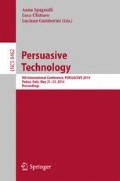Abstract
The International Agency for Research on Cancer classifies radiofrequency (RF) electromagnetic emissions of cell phones as possibly carcinogenic to humans [1] and suggests the use of hands-free devices such as earphones to reduce direct exposure of the brain to such emissions. In this paper, we present the design of a mobile application that exploits persuasive principles to encourage the use of earphones during cell phone calls. We propose different notifications and visualizations aimed at informing the user about her behavior with respect to earphone use and discuss the results of a user study that was aimed at investigating aspects such as understandability, emotional impact, and perceived usefulness of the proposed solutions. Results of the study are used to inform the design of the application. To the best of our knowledge, this is the first investigation of persuasive technologies applied to the reduction of user’s exposure to cell phone RF emissions.
Access this chapter
Tax calculation will be finalised at checkout
Purchases are for personal use only
Preview
Unable to display preview. Download preview PDF.
References
IARC. Agents classified by the IARC monographs, http://monographs.iarc.fr/ENG/Classi-fication/index.php
Consolvo, S., Klasnja, P., McDonald, D.W., Avrahami, D., Froehlich, J., LeGrand, L., Libby, R., Mosher, K., Landay, J.A.: Flowers or a robot army?: encouraging awareness & activity with personal, mobile displays. In: 10th International Conference on Ubiquitous Computing, pp. 54–63. ACM Press, New York (2008)
Froehlich, J., Dillahunt, T., Klasnja, P., Mankoff, J., Consolvo, S., Harrison, B., Landay, J.A.: Ubigreen: investigating a mobile tool for tracking and supporting green transportation habits. In: 27th International Conference on Human Factors in Computing Systems, pp. 1043–1052. ACM Press, New York (2009)
Shiraishi, M., Washio, Y., Takayama, C., Lehdonvirta, V., Kimura, H., Nakajima, T.: Using individual, social and economic persuasion techniques to reduce CO2 emissions in a family setting. In: 4th International Conference on Persuasive Technology, pp. 13:1–13:8. ACM Press, New York (2009)
Consolvo, S., McDonald, D.W., Landay, J.A.: Theory-driven design strategies for technologies that support behavior change in everyday life. In: 27th International Conference on Human Factors in Computing Systems, pp. 405–414. ACM Press, New York (2009)
Jafarinaimi, N., Forlizzi, J.: Breakaway: An ambient display designed to change human behavior. In: 23rd International Conference on Human Factors in Computing Systems, pp. 1945–1948. ACM Press, New York (2005)
Fogg, B.J.: Persuasive technology: using computers to change what we think and do. Morgan Kaufmann, San Francisco (2003)
Choe, E.K., Kientz, J.A., Halko, S., Fonville, A.A., Sakaguchi, D., Watson, N.F.: Opportunities for computing to support healthy sleep behavior. In: 28th International Conference on Human Factors in Computing Systems, pp. 3661–3666. ACM Press, New York (2010)
Nawyn, J., Intille, S.S., Larson, K.: Embedding behavior modification strategies into a consumer electronic device: a case study. In: 8th International Conference on Ubiquitous Computing, pp. 297–314. ACM Press, New York (2006)
Dillahunt, T., Becker, G., Mankoff, J., Kraut, R.: Motivating environmentally sustainable behavior changes with a virtual polar bear. In: Pervasive 2008 Workshop on Pervasive Persuasive Technology and Environmental Sustainability (2008)
Gerend, M.A., Sias, T.: Message framing and color priming: how subtle threat cues affect persuasion. Journal of Experimental Social Psychology 45(4), 999–1002 (2009)
Klasnja, P., Consolvo, S., McDonald, D.W., Landay, J.A., Pratt, W.: Using mobile and personal sensing technologies to support health behavior change in everyday life: lessons learned. In: Annual Conf. American Medical Informatics Association, pp. 338–342 (2009)
Intille, S.S.: A new research challenge: persuasive technology to motivate healthy aging. IEEE Transactions on Information Technology in Biomedicine 8(3), 235–237 (2004)
Shahab, L., Hall, S., Marteau, T.: Showing smokers with vascular disease images of their arteries to motivate cessation: a pilot study. Br. J. Health Psychol. 12(pt. 2), 275–283 (2007)
Izard, C.E.: Human emotions. Plenum Press, New York (1977)
Eisenberg, N., Strayer, J.: Empathy and its development. Cambridge University Press (1987)
Author information
Authors and Affiliations
Editor information
Editors and Affiliations
Rights and permissions
Copyright information
© 2014 Springer International Publishing Switzerland
About this paper
Cite this paper
Burigat, S., Chittaro, L. (2014). Designing a Mobile Persuasive Application to Encourage Reduction of Users’ Exposure to Cell Phone RF Emissions. In: Spagnolli, A., Chittaro, L., Gamberini, L. (eds) Persuasive Technology. PERSUASIVE 2014. Lecture Notes in Computer Science, vol 8462. Springer, Cham. https://doi.org/10.1007/978-3-319-07127-5_2
Download citation
DOI: https://doi.org/10.1007/978-3-319-07127-5_2
Publisher Name: Springer, Cham
Print ISBN: 978-3-319-07126-8
Online ISBN: 978-3-319-07127-5
eBook Packages: Computer ScienceComputer Science (R0)

